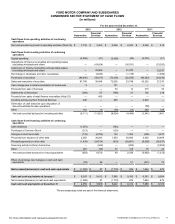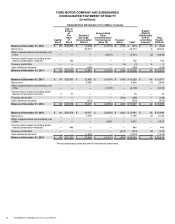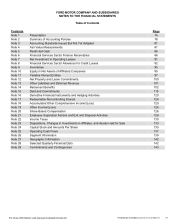Ford 2013 Annual Report Download - page 65
Download and view the complete annual report
Please find page 65 of the 2013 Ford annual report below. You can navigate through the pages in the report by either clicking on the pages listed below, or by using the keyword search tool below to find specific information within the annual report.
Ford Motor Company | 2013 Annual Report 63
Quantitative and Qualitative Disclosures About Market Risk (Continued)
Under these interest rate scenarios, Ford Credit expects more assets than debt and liabilities to re-price in the next
twelve months. Other things being equal, this means that during a period of rising interest rates, the interest earned on
Ford Credit’s assets will increase more than the interest paid on Ford Credit’s debt, thereby initially increasing Ford
Credit’s pre-tax cash flow. During a period of falling interest rates, Ford Credit would expect its pre-tax cash flow to
initially decrease. Ford Credit’s pre-tax cash flow sensitivity to interest rate movement is highlighted in the table below.
Pre-tax cash flow sensitivity as of year-end 2013 and 2012 was as follows (in millions):
Pre-Tax Cash Flow Sensitivity (given a
one percentage point instantaneous
increase in interest rates)
Pre-Tax Cash Flow Sensitivity (given a
one percentage point instantaneous
decrease in interest rates) (a)
December 31, 2013 $ 63 $ (63)
December 31, 2012 77 (77)
_____
(a) Pre-tax cash flow sensitivity given a one percentage point decrease in interest rates requires an assumption of negative interest rates in markets
where existing interest rates are below one percent.
While the sensitivity analysis presented is Ford Credit’s best estimate of the impacts of the specified assumed interest
rate scenarios, its actual results could differ from those projected. The model Ford Credit uses to conduct this analysis is
heavily dependent on assumptions. Embedded in the model are assumptions regarding the reinvestment of maturing
asset principal, refinancing of maturing debt, replacement of maturing derivatives, exercise of options embedded in debt
and derivatives, and predicted repayment of retail installment sale and lease contracts ahead of contractual maturity.
Ford Credit’s repayment projections ahead of contractual maturity are based on historical experience. If interest rates or
other factors change, Ford Credit’s actual prepayment experience could be different than projected.
Foreign Currency Risk. Ford Credit’s policy is to minimize exposure to changes in currency exchange rates. To meet
funding objectives, Ford Credit borrows in a variety of currencies, principally U.S. dollars, Canadian dollars, Euros and
Pound Sterling. Ford Credit faces exposure to currency exchange rates if a mismatch exists between the currency of
receivables and the currency of the debt funding those receivables. When possible, receivables are funded with debt in
the same currency, minimizing exposure to exchange rate movements. When a different currency is used, Ford Credit
may use foreign currency swaps and foreign currency forwards to convert substantially all of its foreign currency debt
obligations to the local country currency of the receivables. As a result of this policy, Ford Credit believes its market risk
exposure relating to changes in currency exchange rates is insignificant.
Derivative Fair Values. The net fair value of Ford Credit’s derivative financial instruments as of December 31, 2013
was an asset of $79 million, compared to an asset of $856 million as of December 31, 2012.
For more information visit www.annualreport.ford.com
























